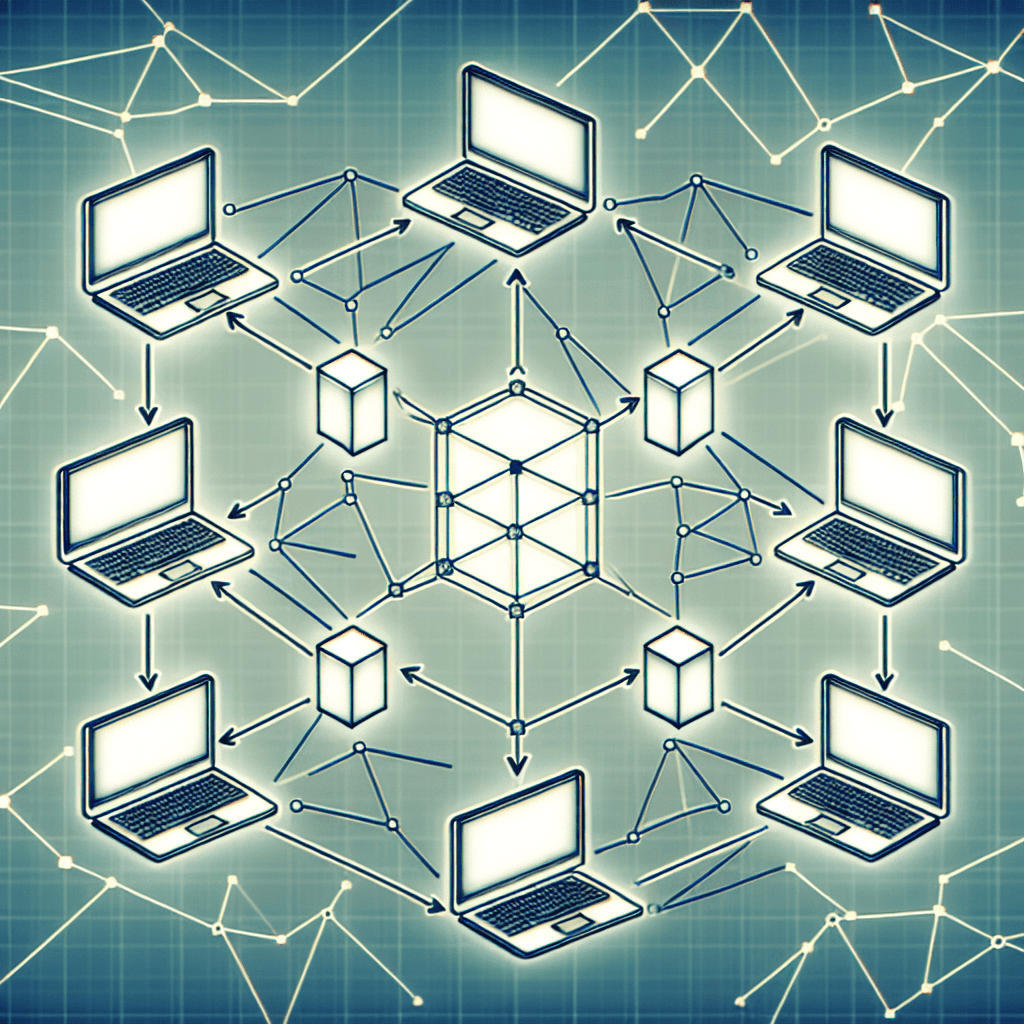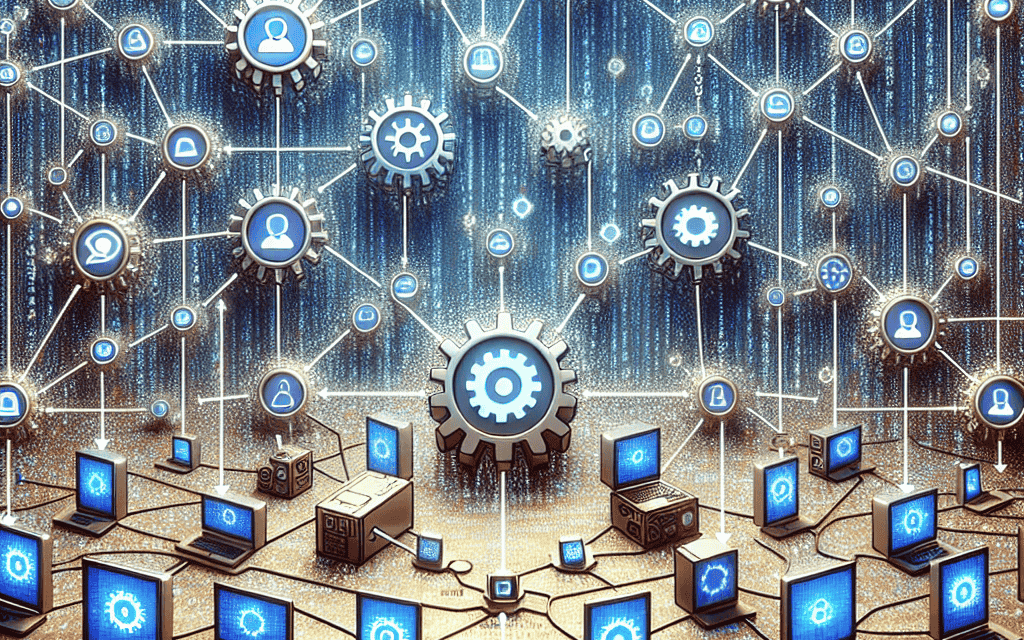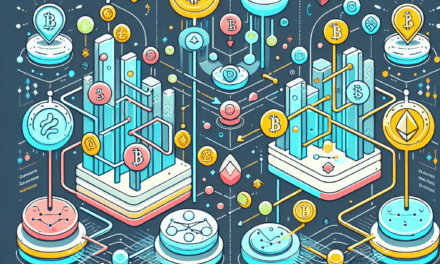“Unleashing the Power of Decentralization: Dive Deep into the World of Dapps”
Introduction
Decentralized applications, commonly known as dApps, represent a revolutionary shift in the way software applications are developed and deployed. Unlike traditional applications that run on centralized servers, dApps operate on decentralized networks, typically leveraging blockchain technology. This architecture ensures that no single entity has control over the entire system, enhancing security, transparency, and resilience against censorship. By utilizing smart contracts—self-executing contracts with the terms of the agreement directly written into code—dApps automate processes and transactions, reducing the need for intermediaries. As a result, they offer users greater autonomy and trust, fostering an ecosystem where data and operations are distributed across a network of nodes. This deep dive into dApps explores their underlying principles, benefits, challenges, and the transformative potential they hold for various industries.
Introduction To Dapps: Understanding The Basics
Decentralized applications, commonly referred to as dapps, represent a transformative shift in the way software applications are developed and operated. Unlike traditional applications that run on centralized servers, dapps operate on decentralized networks, typically leveraging blockchain technology. This fundamental difference in architecture offers a range of benefits, including enhanced security, transparency, and user control. To fully appreciate the potential of dapps, it is essential to understand their underlying principles and how they differ from conventional applications.
At the core of a dapp is the blockchain, a distributed ledger that records transactions across a network of computers. This decentralized nature ensures that no single entity has control over the entire network, thereby reducing the risk of censorship and single points of failure. Consequently, dapps are inherently more resilient to attacks and downtime compared to their centralized counterparts. Furthermore, the transparency of blockchain technology allows users to verify transactions and data independently, fostering a higher level of trust in the application.
Another defining characteristic of dapps is their reliance on smart contracts. These are self-executing contracts with the terms of the agreement directly written into code. Smart contracts automate processes and transactions, eliminating the need for intermediaries and reducing the potential for human error. This automation not only streamlines operations but also lowers costs, making dapps an attractive option for businesses and consumers alike.
In addition to their technical advantages, dapps offer a new paradigm for user interaction and data ownership. Traditional applications often require users to relinquish control of their data to centralized entities, which can lead to privacy concerns and data breaches. In contrast, dapps empower users by allowing them to retain ownership of their data and digital assets. This shift in control is facilitated by the use of cryptographic keys, which enable users to securely manage their identities and transactions on the network.
Despite these advantages, the adoption of dapps is not without challenges. One of the primary obstacles is scalability. As dapps gain popularity, the demand on blockchain networks increases, potentially leading to slower transaction times and higher fees. Developers are actively working on solutions to address these issues, such as layer 2 scaling solutions and more efficient consensus algorithms. Additionally, the user experience of dapps can be less intuitive than traditional applications, as they often require users to have a basic understanding of blockchain technology and digital wallets.
Moreover, the regulatory landscape for dapps remains uncertain. As governments and regulatory bodies grapple with the implications of decentralized technologies, dapp developers must navigate a complex web of legal and compliance issues. This uncertainty can hinder innovation and slow the adoption of dapps in certain regions.
Nevertheless, the potential of dapps to revolutionize industries is undeniable. From finance and supply chain management to healthcare and social media, dapps have the potential to disrupt traditional business models and create new opportunities for innovation. As the technology matures and scalability solutions are implemented, it is likely that dapps will become an integral part of the digital ecosystem.
In conclusion, decentralized applications represent a significant evolution in software development, offering numerous benefits over traditional applications. While challenges remain, the continued advancement of blockchain technology and the growing interest in decentralized solutions suggest a promising future for dapps. As more individuals and organizations recognize the value of decentralization, the adoption of dapps is poised to accelerate, paving the way for a more secure, transparent, and user-centric digital landscape.
Key Features Of Decentralized Applications
Decentralized applications, commonly referred to as dapps, represent a significant evolution in the way software applications are developed and deployed. Unlike traditional applications that run on centralized servers, dapps operate on a decentralized network, typically a blockchain. This fundamental difference in architecture brings with it a host of unique features that distinguish dapps from their centralized counterparts.
One of the most prominent features of dapps is their open-source nature. By design, the source code of a dapp is made publicly available, allowing anyone to inspect, modify, and contribute to its development. This transparency fosters a collaborative environment where developers from around the world can work together to improve the application. Moreover, open-source code ensures that the application is subject to rigorous peer review, which can enhance security and reliability.
In addition to being open-source, dapps are characterized by their decentralized nature. They operate on a peer-to-peer network, which means that no single entity has control over the entire application. This decentralization is achieved through the use of blockchain technology, which distributes data across a network of nodes. As a result, dapps are resistant to censorship and single points of failure, making them more robust and reliable than traditional applications.
Another key feature of dapps is their use of smart contracts. Smart contracts are self-executing contracts with the terms of the agreement directly written into code. They automatically enforce and execute the terms of the contract when predefined conditions are met. This automation reduces the need for intermediaries, streamlining processes and reducing costs. Furthermore, smart contracts enhance trust and transparency, as all parties involved can verify the terms and execution of the contract on the blockchain.
Dapps also offer enhanced security compared to traditional applications. The decentralized nature of blockchain technology makes it inherently more secure, as data is distributed across multiple nodes rather than being stored on a single server. This distribution makes it difficult for malicious actors to alter or tamper with the data. Additionally, the use of cryptographic techniques ensures that data is securely encrypted, further protecting it from unauthorized access.
Moreover, dapps provide users with greater control over their data. In traditional applications, user data is often stored and controlled by a central authority, which can lead to privacy concerns and potential misuse of information. In contrast, dapps allow users to retain ownership of their data, as it is stored on a decentralized network. This shift in data ownership empowers users and enhances privacy, as individuals have greater control over who can access their information.
Despite these advantages, it is important to acknowledge that dapps are not without their challenges. Scalability remains a significant issue, as the decentralized nature of blockchain can lead to slower transaction times and higher costs compared to centralized systems. Additionally, the complexity of developing and maintaining dapps can be a barrier to entry for some developers. However, ongoing advancements in blockchain technology and development tools are continually addressing these challenges, paving the way for broader adoption of dapps.
In conclusion, decentralized applications offer a range of key features that set them apart from traditional applications. Their open-source nature, decentralization, use of smart contracts, enhanced security, and user control over data make them a compelling alternative in the digital landscape. As technology continues to evolve, dapps are poised to play an increasingly important role in shaping the future of software development and deployment.
How Dapps Differ From Traditional Apps
Decentralized applications, commonly referred to as dapps, represent a significant shift in the way software applications are developed and operated. Unlike traditional applications, which are typically hosted on centralized servers and controlled by a single entity, dapps operate on decentralized networks, often utilizing blockchain technology. This fundamental difference in architecture leads to several distinct characteristics that set dapps apart from their traditional counterparts.
To begin with, the decentralized nature of dapps means that they are not reliant on a single point of control. Traditional applications are usually managed by a central authority, which has the power to alter the application, control user access, and manage data. In contrast, dapps are governed by smart contracts—self-executing contracts with the terms of the agreement directly written into code. These smart contracts are deployed on a blockchain, ensuring that the application runs exactly as programmed without any possibility of downtime, fraud, or third-party interference. This decentralization enhances security and trust, as users can interact with the application without needing to trust a central authority.
Moreover, dapps are typically open-source, meaning their code is publicly accessible and can be reviewed, modified, and improved by anyone. This transparency fosters a collaborative environment where developers from around the world can contribute to the application’s development, leading to rapid innovation and improvement. In contrast, traditional applications are often proprietary, with their source code kept confidential to protect intellectual property. This openness in dapps not only encourages community involvement but also allows for greater scrutiny, which can lead to more secure and reliable applications.
Another key difference lies in the way data is managed. Traditional applications often store data on centralized servers, which can be vulnerable to hacking, data breaches, and censorship. Dapps, on the other hand, store data on a decentralized network, distributing it across multiple nodes. This distribution makes it significantly more difficult for malicious actors to compromise the data, as they would need to gain control of a majority of the network. Additionally, the decentralized storage of data in dapps ensures greater privacy and resistance to censorship, as no single entity has control over the data.
Furthermore, the economic model of dapps often diverges from that of traditional applications. Many dapps operate on a token-based economy, where users interact with the application using a native cryptocurrency token. These tokens can be used to incentivize user participation, reward developers, and facilitate transactions within the application. This model contrasts with traditional applications, which may rely on subscription fees, advertisements, or in-app purchases for monetization. The token-based economy of dapps not only aligns the interests of users and developers but also enables new business models that were not possible with traditional applications.
In conclusion, while both dapps and traditional applications serve the fundamental purpose of providing software solutions to users, their underlying architectures and operational models differ significantly. Dapps offer enhanced security, transparency, and decentralization, which can lead to greater user trust and engagement. As the technology behind dapps continues to evolve, it is likely that we will see an increasing number of applications adopting this decentralized approach, potentially transforming the landscape of software development and usage.
The Role Of Blockchain In Dapp Development

Decentralized applications, commonly referred to as dapps, represent a transformative shift in the way software applications are developed and deployed. At the heart of this innovation lies blockchain technology, which plays a pivotal role in the development and functioning of dapps. To understand the significance of blockchain in dapp development, it is essential to first grasp the fundamental characteristics that distinguish dapps from traditional applications.
Unlike conventional applications that rely on centralized servers, dapps operate on a decentralized network of computers, often referred to as nodes. This decentralization is made possible by blockchain technology, which provides a distributed ledger that records transactions and data across multiple nodes. Consequently, blockchain ensures that dapps are not controlled by a single entity, thereby enhancing transparency, security, and resilience against censorship or downtime.
One of the primary roles of blockchain in dapp development is to facilitate trustless interactions. In traditional applications, users must place their trust in a central authority to manage and secure their data. However, blockchain eliminates the need for such intermediaries by employing cryptographic techniques to secure data and transactions. This trustless environment is particularly beneficial for applications that require high levels of security and privacy, such as financial services, supply chain management, and identity verification.
Moreover, blockchain technology enables the creation of smart contracts, which are self-executing contracts with the terms of the agreement directly written into code. Smart contracts are a cornerstone of dapp development, as they automate processes and enforce rules without the need for human intervention. By leveraging smart contracts, dapps can offer users a more efficient and reliable way to execute transactions and agreements, reducing the potential for errors and disputes.
In addition to enhancing security and automation, blockchain also plays a crucial role in ensuring the immutability of dapps. Once data is recorded on a blockchain, it cannot be altered or deleted, providing a permanent and tamper-proof record of all transactions and interactions. This immutability is particularly valuable for applications that require a high degree of accountability and auditability, such as voting systems and public records management.
Furthermore, blockchain’s decentralized nature fosters greater inclusivity and accessibility in dapp development. By removing the barriers imposed by centralized authorities, blockchain allows developers from around the world to contribute to and innovate on dapp platforms. This open and collaborative environment encourages the development of a diverse range of applications that cater to various needs and industries.
However, it is important to acknowledge the challenges associated with blockchain-based dapp development. Scalability remains a significant concern, as the decentralized nature of blockchain can lead to slower transaction processing times compared to centralized systems. Additionally, the complexity of blockchain technology can pose a steep learning curve for developers new to the field. Despite these challenges, ongoing advancements in blockchain technology, such as layer 2 solutions and improved consensus mechanisms, continue to address these issues and pave the way for more efficient and scalable dapps.
In conclusion, blockchain technology is integral to the development and operation of decentralized applications. By providing a secure, transparent, and trustless environment, blockchain enables dapps to offer innovative solutions across various sectors. As the technology continues to evolve, it is likely that we will witness an increasing number of dapps that leverage blockchain’s unique capabilities to deliver enhanced functionality and user experiences.
Popular Platforms For Building Dapps
Decentralized applications, commonly known as dapps, have emerged as a revolutionary force in the digital landscape, offering a new paradigm for how applications are built and operated. Unlike traditional applications that run on centralized servers, dapps operate on decentralized networks, typically leveraging blockchain technology to ensure transparency, security, and autonomy. As the interest in dapps continues to grow, several platforms have gained prominence for their ability to facilitate the development of these innovative applications.
Ethereum stands out as the most popular platform for building dapps, primarily due to its pioneering role in introducing smart contracts. Smart contracts are self-executing contracts with the terms of the agreement directly written into code, enabling automated and trustless transactions. Ethereum’s robust infrastructure and extensive developer community make it an attractive choice for developers seeking to create dapps across various sectors, from finance to gaming. The Ethereum Virtual Machine (EVM) provides a runtime environment for executing smart contracts, ensuring that dapps can operate seamlessly across the network. Furthermore, Ethereum’s transition to a proof-of-stake consensus mechanism with Ethereum 2.0 aims to enhance scalability and reduce energy consumption, addressing some of the limitations faced by earlier iterations.
In addition to Ethereum, Binance Smart Chain (BSC) has gained traction as a viable alternative for dapp development. BSC offers compatibility with the EVM, allowing developers to port their Ethereum-based dapps with minimal modifications. This interoperability, combined with lower transaction fees and faster block times, has attracted a significant number of developers and users to the platform. BSC’s dual-chain architecture enables seamless asset transfers between the Binance Chain and Binance Smart Chain, further enhancing its appeal for decentralized finance (DeFi) applications and other dapps that require efficient cross-chain operations.
Polkadot is another noteworthy platform that has captured the attention of the dapp development community. Unlike Ethereum and BSC, Polkadot introduces a unique multi-chain framework that allows different blockchains to interoperate and share information securely. This interoperability is facilitated by Polkadot’s relay chain, which connects various parachains, each capable of hosting its own dapps. By enabling cross-chain communication, Polkadot aims to overcome the scalability challenges faced by single-chain networks, offering developers a flexible and scalable environment for building dapps.
Solana has also emerged as a formidable contender in the dapp ecosystem, particularly for applications requiring high throughput and low latency. Solana’s innovative proof-of-history consensus mechanism allows it to process thousands of transactions per second, making it an ideal platform for dapps that demand rapid execution and minimal transaction costs. The platform’s focus on scalability without compromising decentralization has attracted a growing number of developers, particularly in the realms of DeFi and non-fungible tokens (NFTs).
While these platforms represent some of the most popular choices for dapp development, it is important to recognize that the landscape is continually evolving. New platforms and technologies are emerging, each offering unique features and capabilities that cater to the diverse needs of developers and users. As the demand for decentralized solutions continues to rise, the competition among platforms is likely to intensify, driving further innovation and improvements in the dapp ecosystem. Consequently, developers must carefully evaluate the strengths and limitations of each platform to determine the most suitable environment for their specific dapp projects.
Real-World Use Cases Of Decentralized Applications
Decentralized applications, commonly known as dapps, have emerged as a transformative force in the digital landscape, offering innovative solutions across various sectors. Unlike traditional applications that run on centralized servers, dapps operate on decentralized networks, typically leveraging blockchain technology. This fundamental difference endows dapps with unique characteristics such as transparency, security, and resistance to censorship. As the world increasingly embraces decentralization, the real-world use cases of dapps are expanding, showcasing their potential to revolutionize industries.
One of the most prominent sectors where dapps have made a significant impact is finance. Decentralized finance, or DeFi, has gained substantial traction by providing financial services without intermediaries. Through dapps, users can engage in activities such as lending, borrowing, and trading cryptocurrencies directly with one another. This peer-to-peer interaction not only reduces costs but also enhances accessibility, particularly for individuals in regions with limited access to traditional banking services. Moreover, DeFi dapps offer users greater control over their assets, as they eliminate the need for third-party custodians, thereby reducing the risk of fraud and mismanagement.
Transitioning from finance to the realm of digital art and collectibles, dapps have also played a pivotal role in the rise of non-fungible tokens (NFTs). NFTs are unique digital assets that represent ownership of a specific item or piece of content, such as artwork, music, or virtual real estate. Dapps facilitate the creation, buying, and selling of NFTs on blockchain platforms, ensuring the authenticity and provenance of these digital assets. This has opened new avenues for artists and creators to monetize their work, while also providing collectors with a secure and transparent way to invest in digital art. The NFT market has witnessed exponential growth, underscoring the transformative potential of dapps in reshaping the creative economy.
In addition to finance and digital art, dapps are making strides in the gaming industry. Blockchain-based games utilize dapps to offer players true ownership of in-game assets, which can be traded or sold outside the game environment. This contrasts with traditional games, where players’ assets are typically confined within the game’s ecosystem. By leveraging dapps, game developers can create decentralized marketplaces where players can freely exchange items, thereby enhancing the gaming experience and fostering vibrant virtual economies. Furthermore, the integration of blockchain technology ensures that game mechanics are transparent and fair, addressing long-standing concerns about cheating and manipulation.
Beyond these sectors, dapps are also being explored for their potential in supply chain management. By utilizing blockchain’s immutable ledger, dapps can provide end-to-end visibility and traceability of goods as they move through the supply chain. This transparency helps in verifying the authenticity of products, reducing fraud, and ensuring compliance with regulatory standards. Companies can leverage dapps to streamline operations, enhance trust with consumers, and improve overall efficiency.
In conclusion, the real-world use cases of decentralized applications are vast and varied, spanning finance, digital art, gaming, and supply chain management, among others. As dapps continue to evolve and mature, they hold the promise of transforming traditional industries by offering decentralized, transparent, and secure solutions. The ongoing development and adoption of dapps signal a shift towards a more decentralized digital future, where individuals and organizations can operate with greater autonomy and trust.
Future Trends And Challenges In The Dapp Ecosystem
Decentralized applications, or dapps, have emerged as a transformative force in the digital landscape, offering a new paradigm for how applications are built and operated. As we look to the future, the dapp ecosystem is poised for significant growth, yet it also faces a myriad of challenges that could shape its trajectory. Understanding these future trends and challenges is crucial for stakeholders aiming to harness the potential of dapps.
To begin with, one of the most promising trends in the dapp ecosystem is the increasing adoption of blockchain technology across various industries. As more sectors recognize the benefits of decentralization, such as enhanced security, transparency, and user control, the demand for dapps is expected to rise. This trend is particularly evident in finance, where decentralized finance (DeFi) applications are revolutionizing traditional banking and investment models. Moreover, the gaming industry is also witnessing a surge in dapp development, with blockchain-based games offering players true ownership of in-game assets.
In addition to industry-specific growth, the evolution of blockchain technology itself is likely to drive the future of dapps. Innovations such as layer-2 scaling solutions and interoperability protocols are addressing some of the current limitations of blockchain networks, such as high transaction fees and limited scalability. These advancements are expected to enhance the performance and user experience of dapps, making them more accessible to a broader audience. Furthermore, the integration of artificial intelligence and machine learning with dapps could unlock new possibilities, enabling more sophisticated and personalized applications.
However, alongside these promising trends, the dapp ecosystem faces several challenges that could impede its progress. One of the most significant hurdles is regulatory uncertainty. As governments around the world grapple with how to regulate blockchain technology and cryptocurrencies, dapp developers must navigate a complex and evolving legal landscape. This uncertainty can stifle innovation and deter investment, as businesses may be hesitant to commit resources to projects that could face future regulatory hurdles.
Another challenge is the issue of user adoption. While dapps offer numerous advantages over traditional applications, they often require users to have a certain level of technical knowledge, such as understanding how to use cryptocurrency wallets. This learning curve can be a barrier to entry for many potential users, limiting the widespread adoption of dapps. To overcome this challenge, developers must focus on creating more user-friendly interfaces and educational resources to demystify the technology for the average user.
Security is also a critical concern in the dapp ecosystem. While blockchain technology is inherently secure, the applications built on top of it can still be vulnerable to attacks. Smart contract bugs and vulnerabilities have led to significant financial losses in the past, highlighting the need for rigorous security audits and testing. As the ecosystem grows, ensuring the security and reliability of dapps will be paramount to maintaining user trust and confidence.
In conclusion, the future of the dapp ecosystem is filled with both opportunities and challenges. As blockchain technology continues to evolve and gain traction across various industries, the potential for dapps to transform how we interact with digital applications is immense. However, addressing regulatory, adoption, and security challenges will be crucial for realizing this potential. By navigating these complexities, the dapp ecosystem can pave the way for a more decentralized and equitable digital future.
Q&A
1. **What is a Dapp?**
A Dapp, or decentralized application, is a software application that runs on a blockchain or peer-to-peer network of computers instead of relying on a single centralized server.
2. **How do Dapps differ from traditional apps?**
Unlike traditional apps, Dapps operate on decentralized networks, providing increased security, transparency, and resistance to censorship.
3. **What are the key components of a Dapp?**
A Dapp typically consists of a smart contract (backend code running on a blockchain) and a user interface (frontend code).
4. **What blockchain platforms support Dapps?**
Ethereum is the most popular platform for Dapps, but others like Binance Smart Chain, Solana, and Polkadot also support them.
5. **What are some common use cases for Dapps?**
Dapps are used in various sectors, including finance (DeFi), gaming, supply chain, social media, and identity verification.
6. **What are the advantages of using Dapps?**
Dapps offer benefits such as enhanced security, transparency, user control, and reduced downtime due to their decentralized nature.
7. **What challenges do Dapps face?**
Dapps face challenges like scalability issues, complex user interfaces, regulatory uncertainty, and the need for widespread adoption.
Conclusion
Decentralized applications, or dApps, are software applications that run on a blockchain or peer-to-peer network of computers instead of relying on a single centralized server. They leverage smart contracts to execute transactions and operations autonomously, ensuring transparency, security, and trustlessness. dApps are typically open-source, allowing for community collaboration and innovation, and they often use tokens to incentivize participation and governance. By eliminating intermediaries, dApps offer enhanced privacy and control to users, fostering a new paradigm in digital interaction and commerce. As blockchain technology continues to evolve, dApps are poised to transform various industries by providing decentralized solutions that challenge traditional centralized models.





